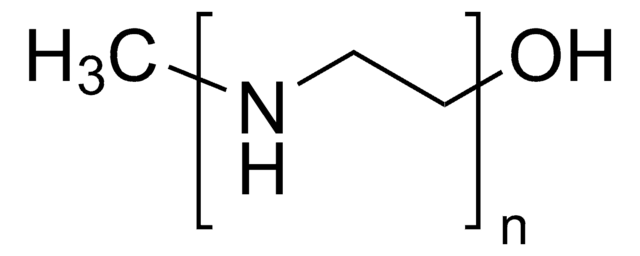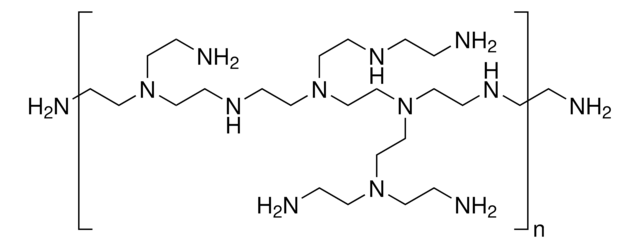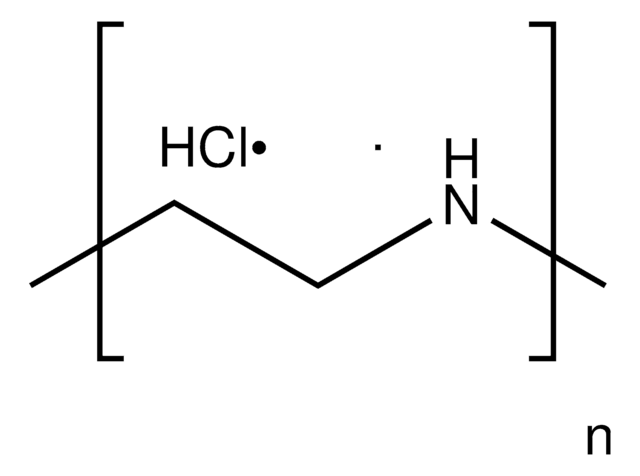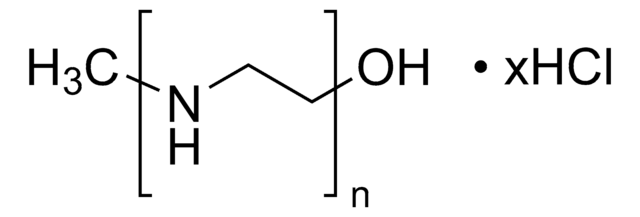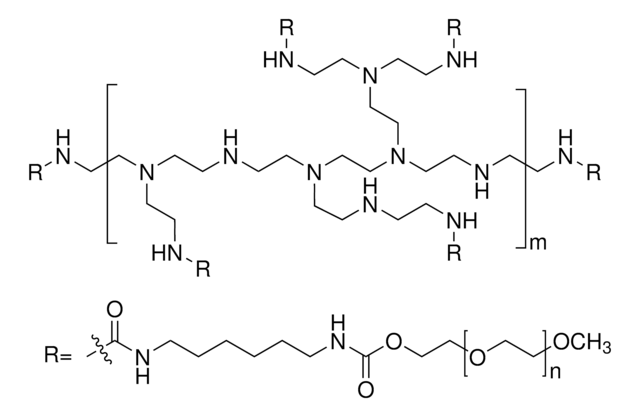929867
Linear polyethylenimine-block-poly(ethylene glycol)
PEG average Mn 2,000, PEI average Mn 30,000
Synonym(s):
PEG-b-PEI, PEG-PEI, Poly(ethylene glycol)-block-polyethylenimine
Sign Into View Organizational & Contract Pricing
All Photos(1)
About This Item
Linear Formula:
CH3(C2H4O)n(C2H5N)mOH
UNSPSC Code:
12162002
NACRES:
NA.25
Recommended Products
form
powder or solid
Quality Level
mol wt
PEG Mn 2000 Da
PEG average Mn 2,000
PEI Mn 30000 Da
PEI average Mn 30,000
color
white to pale yellow
storage temp.
2-8°C
Looking for similar products? Visit Product Comparison Guide
General description
Linear polyethylenimine-block-poly(ethylene glycol) (PEG-b-PEI) is a block copolymer of cationic poly(ethylene imine) (PEI) and hydrophilic poly(ethylene glycol) (PEG). PEI is one of the most commonly used cationic polymers for gene delivery applications and PEG improves nucleic acid delivery by producing a stealth barrier.
Application
Due to their low immunogenicity profiles, polymeric non-viral vectors have shown promise in advancing the treatment of many severe genetic and acquired diseases via gene therapy.
Features and Benefits
Copolymers of PEI and hydrophilic poly(ethylene glycol) have been designed to provide a stealth-like shield around polymer/DNA complexes, reducing nonspecific interactions, inhibiting activation of the reticuloendothelial system, and prolonging the half-life of the complexes in the blood.
Storage Class Code
11 - Combustible Solids
WGK
WGK 3
Flash Point(F)
Not applicable
Flash Point(C)
Not applicable
Regulatory Information
新产品
Choose from one of the most recent versions:
Certificates of Analysis (COA)
Lot/Batch Number
Don't see the Right Version?
If you require a particular version, you can look up a specific certificate by the Lot or Batch number.
Already Own This Product?
Find documentation for the products that you have recently purchased in the Document Library.
B Brissault et al.
Biomacromolecules, 7(10), 2863-2870 (2006-10-10)
The study of ethyloxazoline/methyloxazoline (EtOXZ/MeOXZ) copolymerization, initiated by methyl tosylate (MeOTs), showed that (i) incorporation of MeOXZ units into random copolymer becomes effective over DP = 100 and (ii) propagation process proceeds with negligible transfer to monomer up to a
Pallab Banerjee et al.
Bioconjugate chemistry, 17(1), 125-131 (2006-01-19)
A block copolymer of a hyperbranched poly(ethylene glycol)-like core and linear polyethylenimine (HBP) was synthesized by a facile synthetic route that included (1) a single-step cationic copolymerization of diepoxy and polyhydroxyl monomers, (2) derivatization of hydroxyl groups of the core
Dagmar Fischer et al.
Drug metabolism and disposition: the biological fate of chemicals, 32(9), 983-992 (2004-08-21)
The in vivo body distribution and the pharmacokinetics of a 20mer double-stranded nuclear factor kappaB decoy oligodeoxynucleotide (ODN) complexed with 25-kDa poly(ethylene imine) (PEI), low molecular weight 2.7-kDa PEI, and PEGylated PEI [bPEI(25k)-glPEG(550)(50)] after intravenous injection were studied in BALB/c
Our team of scientists has experience in all areas of research including Life Science, Material Science, Chemical Synthesis, Chromatography, Analytical and many others.
Contact Technical Service